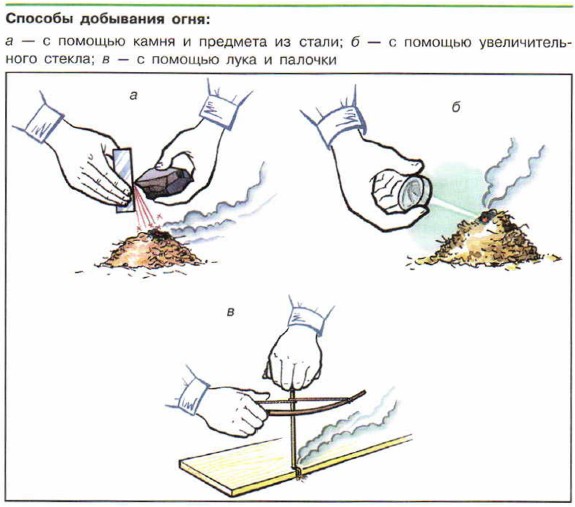Ensuring human life in the natural environment with autonomous existence
To ensure your safety in the natural environment, you need to be able not only to navigate the terrain and move along the route in a given direction, but also to build a temporary shelter from improvised means from wind, rain, snow, etc., provide yourself with drinking water, make a fire , cook food on it, use distress signals. It is also necessary to know which plants, berries and mushrooms can be used as food. We will tell you more about this.
Construction of a temporary shelter from improvised means
If in natural conditions you need to build a temporary shelter (for example, if the weather deteriorates, or the night is approaching, or you decide to wait for a group of rescuers on the spot), then you first need to determine for what purposes you need it (to protect yourself from rain, cold , wind, etc.), what building materials you can use and what tools you have (shovel, axe, oars, knife, etc.). Depending on this, you can determine which type of shelter suits you. There are several types of temporary shelters: a canopy, a barrier, a hut, a snow trench, a snow cave, etc. The choice of the type of shelter also depends on the season, your skill, diligence and physical condition. Then you need to choose a place for temporary shelter. First of all, it should be dry and, if possible, be close to water (stream, river). It is necessary to clear the selected site well, and then prepare the building material (poles, spruce branches, branches, bark, etc.). The main types of shelters are given in Appendix 3.
With autonomous existence in natural conditions, the ability to make fire and build a fire increases a person’s chances of survival. A fire is needed for heating, drying clothes, cooking, and sending distress signals.
If you have matches or a lighter, you can make a fire in any weather. Therefore, experienced tourists and travelers advise every person who is in nature to have matches, which are included in the so-called wearable emergency stock (NAP) and are stored in a plastic bag.

What if there are no matches? Ancient man used to make fire flint, flint and tinder. As tinder, you can use dry moss, finely crushed bark, wood dust, which can be found under the bark of dried trees.
As a flint, you can use a hard stone, as a flint (or flint) - a knife blade or any object made of steel.
To get fire in this way, the stone should be kept as close as possible to the tinder, hitting the stone with a flint so that the sparks fall on the middle of the tinder. When the tinder begins to slowly smolder, you need to fan this smoldering until a fire appears, from which you can set fire to the kindling prepared in advance.
Fire can be made on a sunny day with magnifying glass by focusing the sun's rays on the tinder. As a magnifying glass, you can use the lens of a camera, the convex lens of binoculars or a flashlight.
There is another way to make fire - with the help of onions and sticks. To do this, a bow is made from a meter-long trunk of a young birch 2-3 cm thick by pulling the trunk with a shoelace or a rope. The stick is made from a pencil-thick pine branch, 25-30 cm long, sharpened at one end.
A pointed stick, wrapped once with a bowstring, is inserted into the recess of a piece of hardwood (for example, birch). Then they press the stick with one hand from above, having previously placed a gasket between the palm and the stick. With the other hand, they begin to quickly drive the bow back and forth perpendicular to the stick. From friction in the hole, the temperature rises and a black powdery dust is formed, in which smoke first appears, and then a flame. Then tinder is added to the hole and the fire is fanned.
It should be noted that in order to make fire in these ways, great perseverance and patience will be required.
Provision of drinking water
Natural water (except spring water and water from high-mountain clean streams) must be purified before use. The water of rivers, lakes and other surface water bodies is often undrinkable, as it may contain pathogenic microbes, pesticides and other toxic substances. If you took water from an unverified source, it should be boiled for at least 30 minutes. It is not recommended to take water directly from a lake or swamp. On a low bank, a few meters from the water, you need to dig a hole, and when it is filled with water, carefully scoop out the water. By repeating this operation two or three times, you can get purified water from this hole, which can be consumed after boiling.
You can disinfect water with potassium permanganate by making a pale pink solution and keeping it for an hour; you can use a 5% alcohol iodine tincture (add two or three drops of iodine to 1 liter of water, mix well and let stand for 1 hour).

An accessible source of water in nature are moisture-containing plants, such as birch, which gives birch sap. You can get water if you put a plastic bag on a branch of a deciduous tree, put a pebble on its bottom and tightly tie the bag at the base. After some time, drops of moisture will appear on the inside of the film, which will drain to the bottom of the bag. You can drink morning dew if you learn how to collect it. To do this, in the evening you need to put a bunch of small stones (pebbles) on a tarpaulin, and by morning water will collect on it.